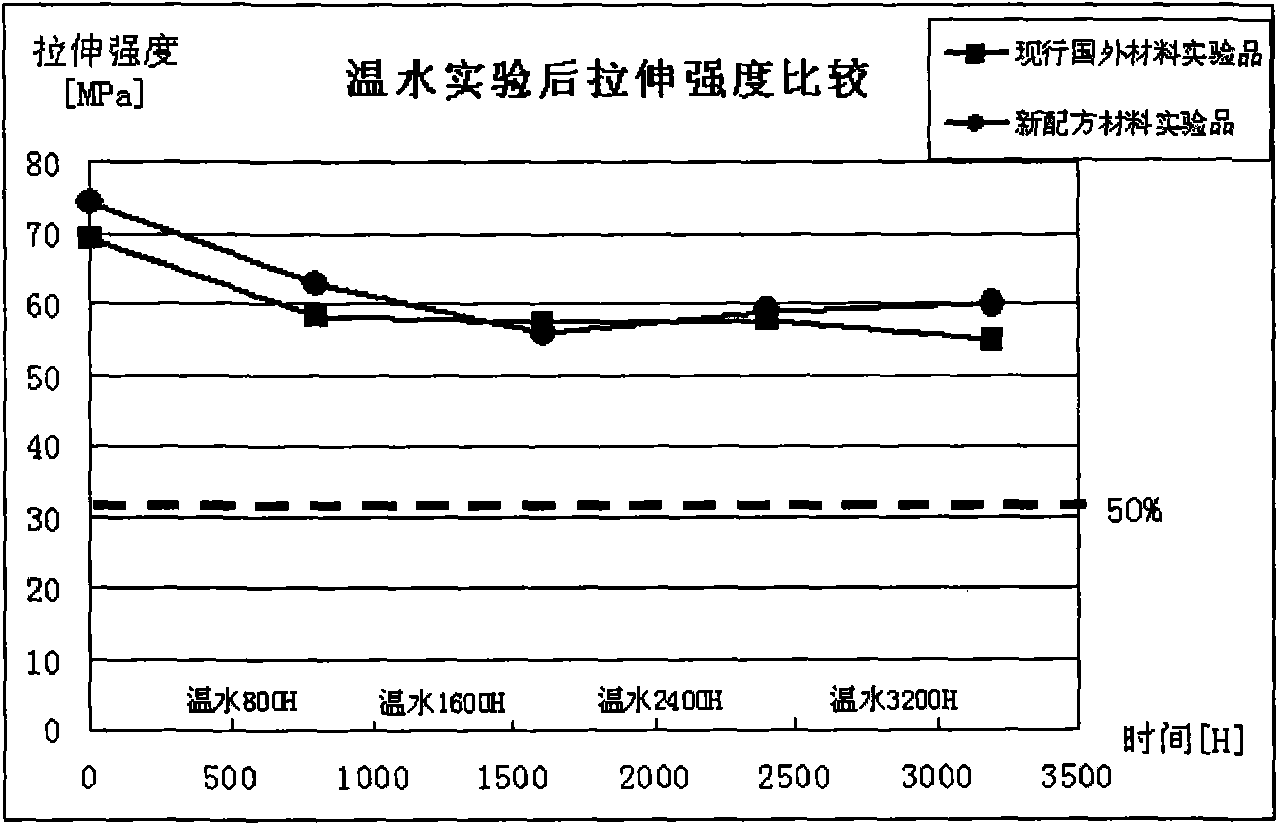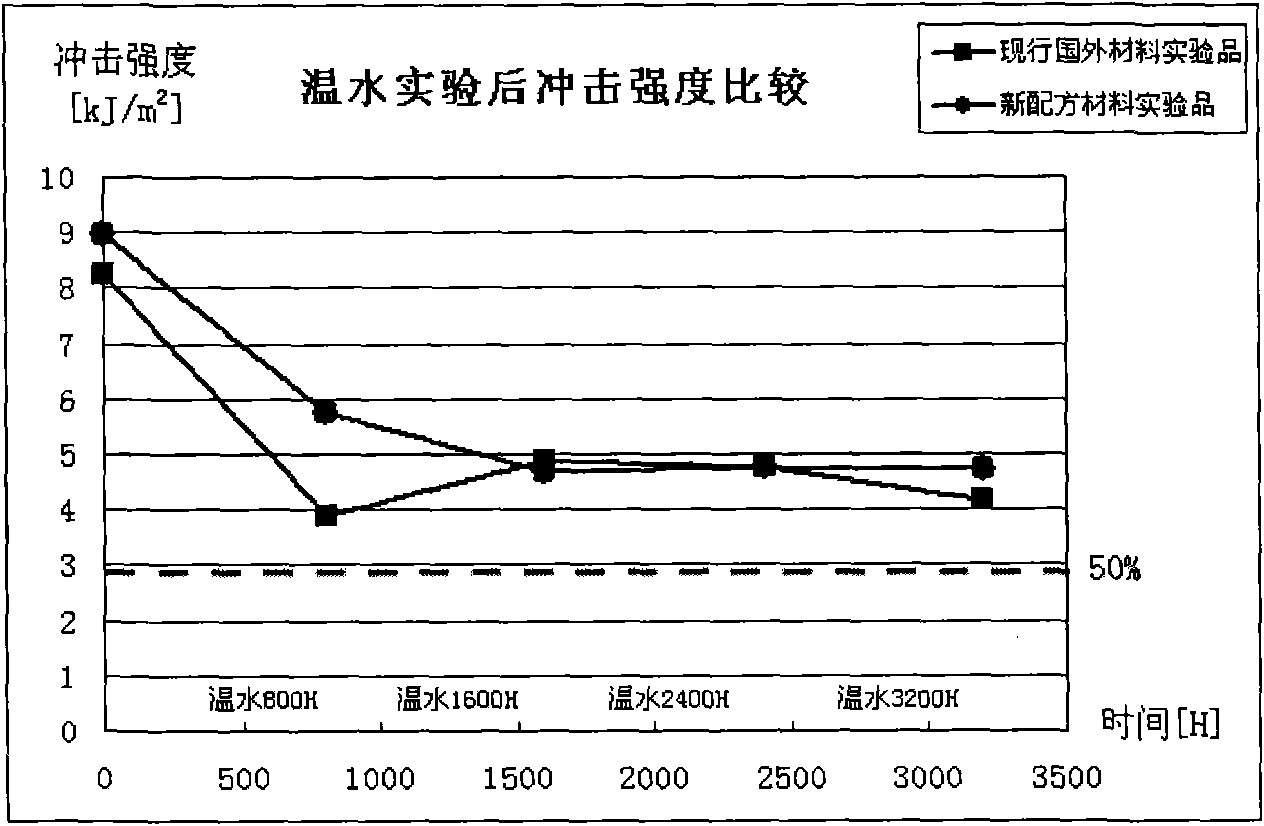Glass fiber reinforced polypropylene material and hydrolysis resistance and oxidation resistance evaluation method thereof
A technology of polypropylene material and copolymerized polypropylene, which is applied in the field of glass fiber reinforced polypropylene material and its hydrolysis resistance and oxidation resistance evaluation, can solve the problems of lack of universality and incompatible with the actual oxidation mechanism of the material, and achieves low price and high production efficiency. The effect of low cost and constant amount of oxygen
- Summary
- Abstract
- Description
- Claims
- Application Information
AI Technical Summary
Problems solved by technology
Method used
Image
Examples
Embodiment 1
[0051](1) Add 25 parts of copolymerized polypropylene and / or 50 parts of homopolypropylene, and 3 parts of compatibilizer maleic anhydride into the high-mix tank in turn, mix thoroughly, and then add the main antioxidant 10101 into the high-mix tank 3301 parts, 1 part of auxiliary antioxidant DLTDP, 6271 parts, 10240.4 parts of metal deactivator MD, 0.3 parts of calcium stearate, 0.3 parts of erucamide. Then mix in the high mixer for 3 minutes, put it into the lower hopper and mix and melt it with a twin-screw machine after mixing fully. Section 220°C, fifth section 220°C, sixth section 210°C, seventh section 200°C, eighth section 200°C, ninth section 210°C, melt temperature 220°C, head temperature 220°C;
[0052] (2) The treated glass fiber is metered and added through the side feeder of the twin-screw extruder;
[0053] (3) Extrude the strands from the twin-screw machine, cool the strands through water, dry the water on the surface of the strands, and then pelletize;
[00...
Embodiment 2
[0057] (1) Add 10 parts of copolymerized polypropylene and / or 80 parts of homopolypropylene and 5 parts of polypropylene grafted with compatibilizer glycidyl acrylate into the high-mixing tank, mix thoroughly, and then add to the high-mixing tank 2 parts of main antioxidant 330, 1 part of auxiliary antioxidant DLTDP, 1 part of auxiliary antioxidant 627, 0.4 part of metal deactivator MD 1024, 0.3 part of processing aid calcium stearate, 0.3 part of erucamide, in Mix in the high mixer for 3 minutes, put it into the lower hopper after mixing fully, and use a twin-screw machine to mix and melt. The mixing and melting temperature is: 180°C for the first section, 210°C for the second section, 220°C for the third section, and 220°C for the fourth section. ℃, fifth section 220℃, sixth section 210℃, seventh section 200℃, eighth section 200℃, ninth section 210℃, melt temperature 220℃, head temperature 220℃;
[0058] (2) The treated glass fiber is metered and added through the side feede...
Embodiment 3
[0062] (1) Add 80 parts of copolymerized polypropylene and / or 5 parts of homopolypropylene and 8 parts of polypropylene grafted with compatibilizer glycidyl acrylate into the high-mixing tank in turn, mix thoroughly, and then add to the high-mixing tank 2 parts of primary antioxidant 330, 2 parts of auxiliary antioxidant DLTDP, 10.4 parts of metal deactivator Naugard XL-10.4 parts, metal deactivator CL-09-367 0.2 parts, processing aid N, N'--ethylene bis Mix 0.3 parts of stearamide and 0.3 parts of polyethylene wax in a high mixer for 3 minutes, put them into the lower hopper and melt them with a twin-screw machine after mixing well. ℃, the third section 220°C, the fourth section 220°C, the fifth section 220°C, the sixth section 210°C, the seventh section 200°C, the eighth section 200°C, the ninth section 210°C, the melt temperature 220°C, Head temperature 220°C;
[0063] (2) The treated glass fiber is metered and added through the side feeder of the twin-screw extruder;
[...
PUM
 Login to View More
Login to View More Abstract
Description
Claims
Application Information
 Login to View More
Login to View More - R&D
- Intellectual Property
- Life Sciences
- Materials
- Tech Scout
- Unparalleled Data Quality
- Higher Quality Content
- 60% Fewer Hallucinations
Browse by: Latest US Patents, China's latest patents, Technical Efficacy Thesaurus, Application Domain, Technology Topic, Popular Technical Reports.
© 2025 PatSnap. All rights reserved.Legal|Privacy policy|Modern Slavery Act Transparency Statement|Sitemap|About US| Contact US: help@patsnap.com



